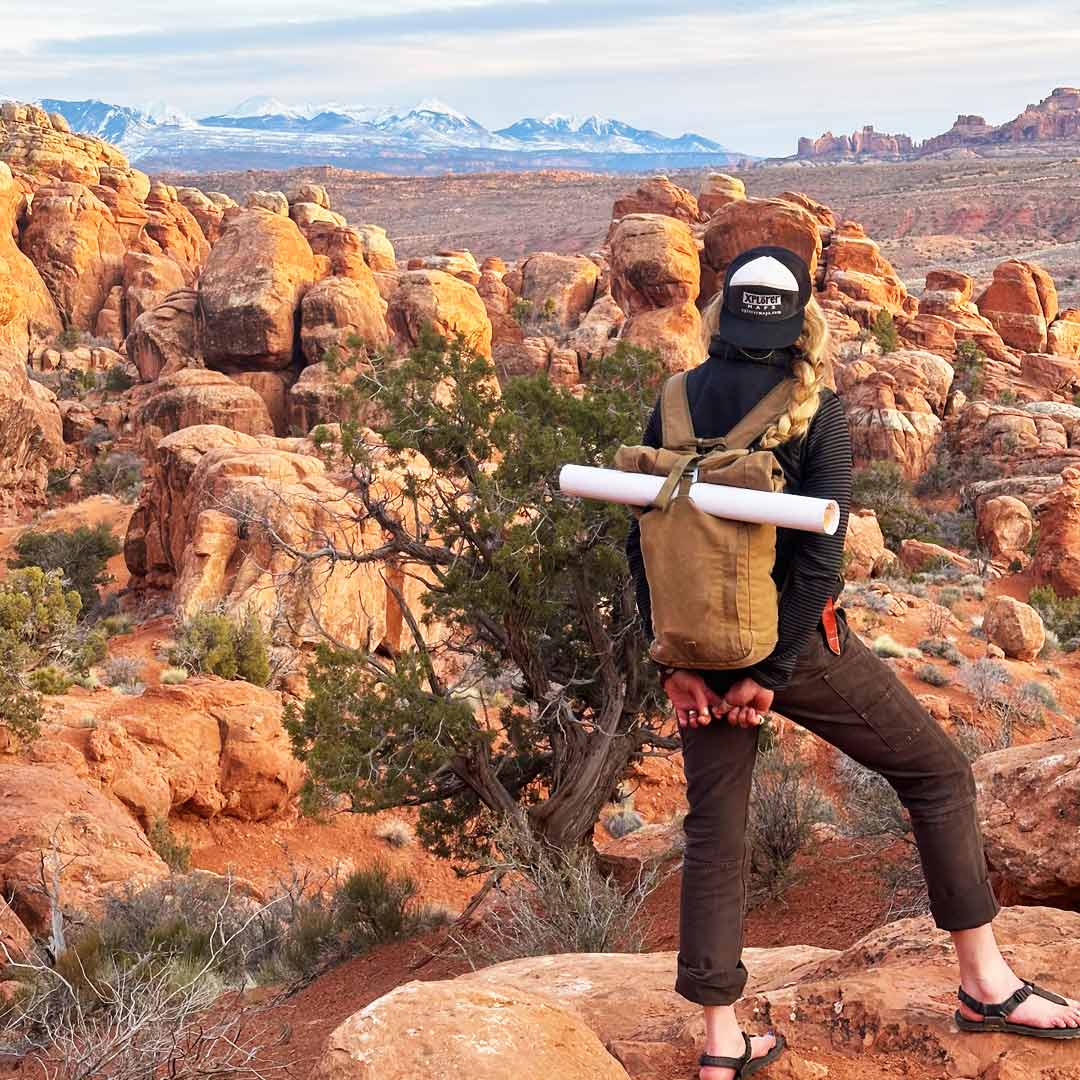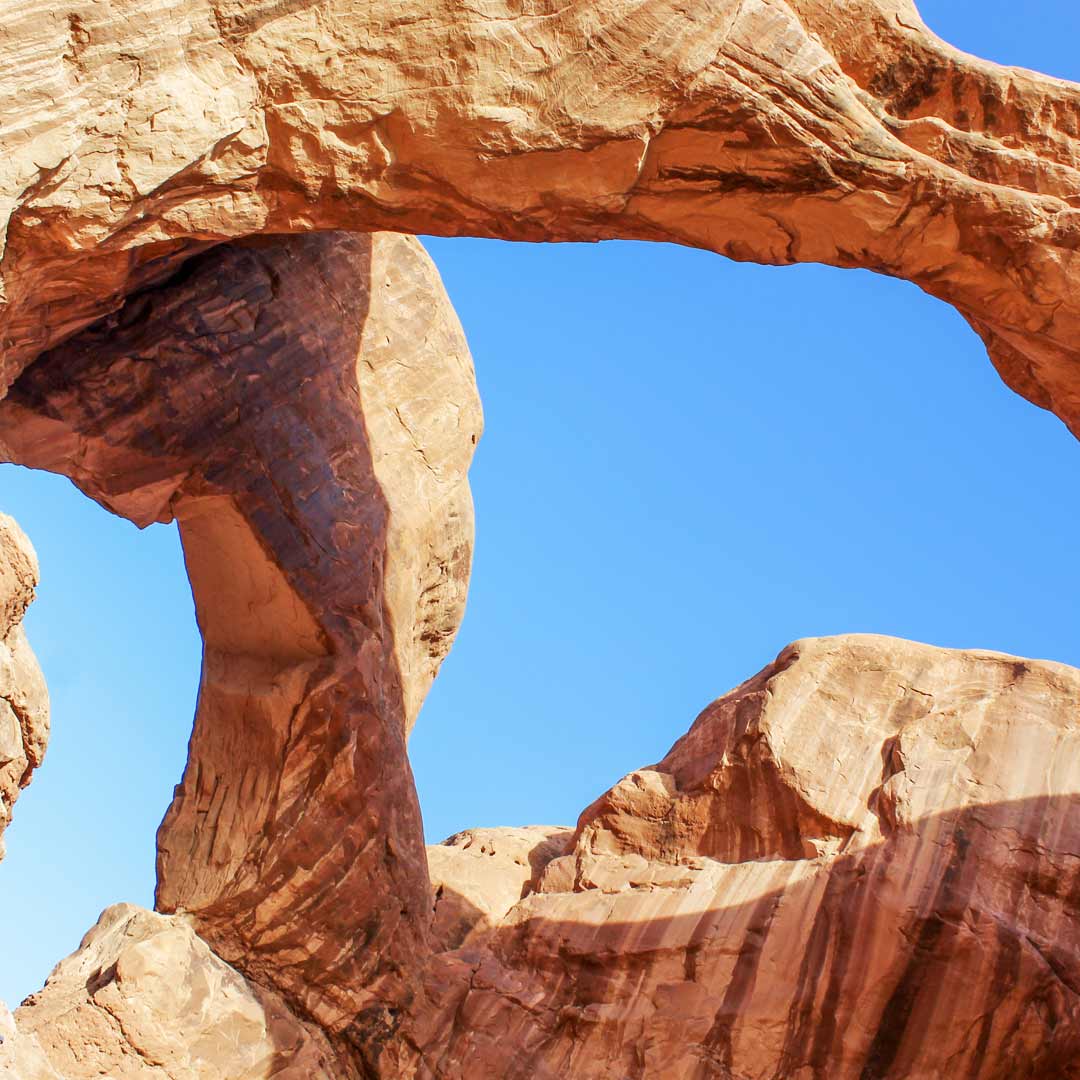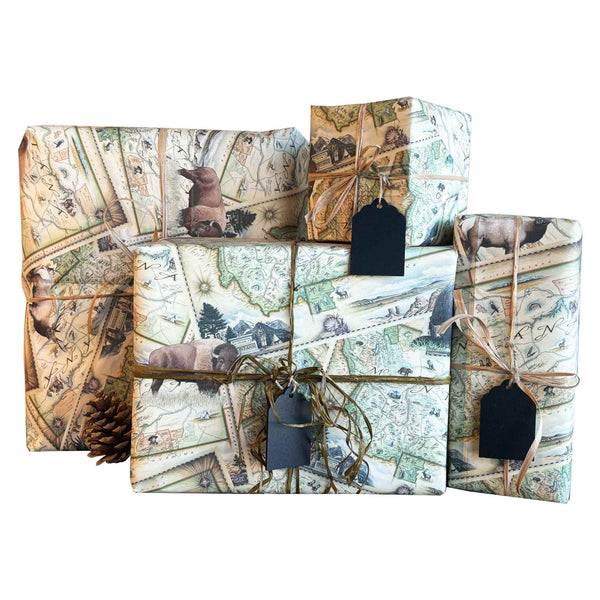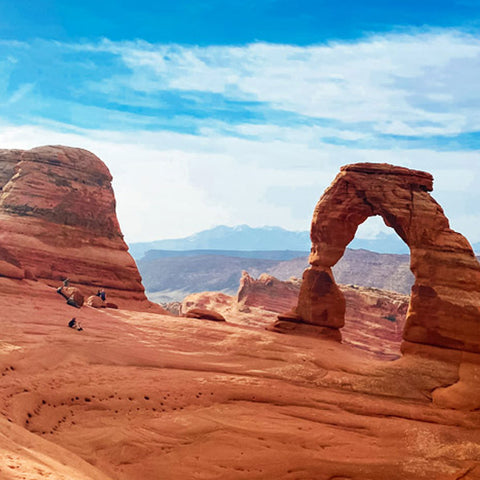Visiting Arches National Park: Connecting People and Place
Connecting With Arches National Park: Responsible Exploration Tips
The epic vistas encountered in Arches National Park are unique - a perfect escape for nature lovers, geology enthusiasts, and those looking to connect with history and the land. Established as a national monument on April 12, 1929, and subsequently becoming a national park in 1971, Arches sits among the 63 sites of unique natural beauty and significance in the United States - all at the center of celebrations throughout the month of April.
We are kicking off a series of blogs delving into the importance of people and place in our National Parks and worldwide, and it seems only fitting that we should start with Arches. In this article, you’ll find out why it’s such a special place for Xplorer Maps and our family, how to visit it responsibly, and what are some of the ways we’re honoring Arches and national parks, while celebrating Earth Day, throughout April.
We’re celebrating all national parks and Earth Day by offering you half off your second purchase when you buy one item in the National Parks collections. Apply code NPWeek24 at checkout to benefit.
XXX
A Brief Introduction to National Parks
Mandela van Eeden, Xplorer Maps Lead Storyteller and World Xplorer, summarizes the importance of national parks: “Public lands are a privilege, and with privilege comes responsibility.” The concept of protecting special places so that future visitors can continue to enjoy them can be traced back to Yellowstone being designated a National Park in 1872. As the NPS describes, the idea has evolved and expanded to go from protecting a natural wonder to recognizing the significance of these places’ connection to human history and to educating generations.
National parks are particularly important for Xplorer Maps because they speak to our core mission - Connecting People and Place. A map tells a story that you can translate to the on-site visit, but it’s about more than that. Our guiding principles are storytelling and engagement through art, providing memories as well as preparing you for experiencing the places you’ll visit. Through our partnership with 1% For the Planet, we are supporting the non-profit organizations that help these parks grow and flourish. Ultimately, just like the national parks and our partners, the Canyonlands Natural History Association you’ll read about below, we are dedicated to the education and preservation of our public lands and the wildlife within them.

Why Was Arches National Park Established?
Arches National Park has a unique landscape marked by over 2,000 natural stone arches, along with pinnacles, fins, and giant balanced rocks. Beyond the geological formations you’ll encounter here, there is a rich history connected to the park and a vast biological diversity. These all combine to make it a great destination for your hiking vacation or road trip, but it also makes it important to protect it.
The geological diversity is well documented, with a fantastic scenery of red rock awaiting visitors. Some of the best-known locations to admire include the Delicate Arch and the Fiery Furnace. You’ll need a special permit for the latter, or to book a ranger-led hike. Xplorer Maps’ Mandela was there earlier this year and used our hand-drawn map to find her way around and fully experience the area.
Mandela also had some amazing encounters in the park, including with young hiker Oliver, who shares his tips on visiting the park as he is training to become a junior ranger in Arches and Canyonlands National Parks.
The biological diversity in Arches starts from the bottom, with biological soil crusts full of living organisms and potential for life. The high deserts in the Colorado Plateau are continuously faced with rough weather conditions, so cryptobiotic soil like this can make up 70 to 80 percent of the living ground cover. The term “cryptobiotic” refers to the huge amounts of hidden life within micro-fungi, lichens, green algae, mosses, bacteria, and cyanobacteria.
In other words, whenever you think, “it’s just the ground,” you should think again and be extra careful to stick to marked trails when you’re exploring the park (more on that below). Above ground, you’ll also find various birds, lizards, and some small mammals that have adapted to desert life.
Watch Canyonlands Natural History Association Executive Director, Sam Wainer, share his tips about protecting the heritage and biodiversity of the Arches National Park with XM’s Mandela earlier this year:
When it comes to the history and people of the Arches, those looking to explore the past will be spoiled for choice. Discover huts and remnants of the cattle ranches that used to operate here (including Wolfe Ranch cabin on your way to Delicate Arch). Get an idea of what archaic peoples’ movements looked like by checking out rock markings like those on the Courthouse Wash Panel Trail. Or stop and visit the various exhibits on hand at the Visitor Center.
Discovering the Canyonlands Natural History Association’s Role in Moab and the Arches National Park
The Canyonlands Natural History Association (CNHA) plays a fundamental role in supporting the National Park Service throughout southeast Utah. At Xplorer Maps, we’re proud to support their efforts to fund educational, interpretive, and scientific programs in the parks. They’ve been working in the area since 1967, having donated over $20 million to public land partners since their inception.
Executive Director Sam Wainer shared a few of the region’s challenges with us, beyond the necessity of managing the influx of visitors. For example, similar to other popular tourist areas across the nation, the Moab area suffers from a lack of affordable housing, which has an impact on its ability to attract and retain park employees, among others. With more long-term rentals being converted to short-term ones, the CNHA has purchased several brand new homes to offer “soft landing spaces” to federal employees, allowing them to start their immersion into new jobs while looking for more permanent housing on the ground.
Another key element of supporting public lands in Moab is recreating responsibly. We’ve talked about being mindful of our human impact on the environment, but another important point to make is about how visitors interact with the communities around Arches National Park. Remember that you are visiting relatively small towns where people live every day, it’s not just a tourist attraction. So, be respectful and understanding of everyone around you - from locals to different user groups who may appreciate these places in different ways from you.
Arches National Park has its birthday on April 12th, so we’re kicking off Earth Day Week with a special 10% discount on our Arches and Canyonlands collection. Take advantage of this for 4 days, online and at our store in Missoula, MT. You’ll get the reduced price automatically at checkout.
Xx
Why Is Arches National Park So Special?
Yes, Arches National Park is a unique place to visit. It has more natural holes in rocks than anywhere in the world, proportional to its size. It holds fantastic biological diversity and offers up amazing landscapes and recreational opportunities. But there’s so much more - and it’s all about connecting people and place.
For Xplorer Maps co-founder Greg Robitaille, Arches was the first place he and his blended family traveled to almost 15 years ago. Discovering its unique landscapes and enjoying special times hiking and camping in the park is intrinsically linked to a new phase in the Robitaille family life. Greg says it best: “ I had never before visited a place so crazy with rock formations and obviously a totally new paradigm and family dynamic.”
When we spoke to CNHA's Sam Wainer, he shared that Arches holds a special place in his life, too. It’s where he got married - with wedding pictures taken just under Skyline Arch. He also loves the “stillness… the quiet of these remote areas” and the fact that “everything I want in my life converges here [in the Moab region].”
How to Visit Arches National Park
Recreating in national parks comes with warnings and responsibilities so that everyone can get to enjoy these spaces while being mindful of the impact their presence has on the environment and the people around them.
Growing Visitor Numbers
The beauty of Arches rightfully attracts c. 1.5 million visitors every year. To manage this better, particularly during Arches National Park's busy times from April to October, the park has introduced a timed entry system that you need to consider when planning a visit. Beyond allowing visitors to have a more fluid experience when arriving on site, this pilot has also allowed the park to better understand visiting behaviors and adjust to people’s preferences.
Mindful of Nature and History
As Sam explained above, you’ll need to be careful not to damage the site and the historic relics you’re coming into contact with. There are spots with rock art that the human touch can deteriorate, while simply walking off the trail can lead to damaging the biological soil crusts that shape the landscape and house so many living organisms.

So, be mindful of the Arches National Park ecosystem, follow the rules and tips you’ll find in the Visitor Center and at trailheads, and also ensure you leave no trace. Mandela advises: “Bring everything out with you… especially food scraps. An orange peel lasts longer than you’d think in an environment like that.”
Expand Your Reach
You can’t see all of Arches National Park in one day, so it’s important to prepare for your visit ahead of time and work with the permit system if you’re visiting at peak times. Additionally, don’t forget to expand your visit to the area around you to make the most of your trip. Canyonlands National Park is a short drive away, but you can also enjoy countless mountain biking trails or rafting on the Colorado River.
Sam’s tip is to head up into the La Sal Mountains during the hottest months to experience cooler temperatures and lots of exciting new trails and views, too.
Listen to Sam Wainer talk about the work of CNHA and the significance of the Arches to himself personally on the Trail Less Traveled podcast.
Be Prepared
When visiting the Arches National Park, remember you are in a hostile, desert environment. This means ensuring you are prepared for the weather with adequate hydration, but also being ready for conditions to change drastically. You have to have plenty of water at all times, while also looking to get out there earlier or later in the day if it’s a particularly hot time of year.

This Month’s Featured Partnership: Ecology Project International
In addition to helping you discover more about our nation’s national parks and unique destinations, we’re excited to also feature the partnerships that Xplorer Maps has forged with organizations that follow the same ethos as us. As we’re celebrating Earth Day this month, it seems only fitting to put the spotlight on Ecology Project International, who we’re happy to support via our partnership with 1% for the Planet.
Our partnership started two years ago at Missoula Gives - Missoula’s pre-eminent community event for non-profit organizations. We’ve donated over $5,000 to EPI through the sales of signed and numbered Limited Edition Giclée prints (we pass on $200 from each $350 print directly to them), and through the 2022 and 2023 Missoula Gives campaign and other donations. If you’d like to contribute, this hand-drawn map of Costa Rica captures the country and serves as a roadmap for conservation.

Learn more about EPI’s work in the documentary Xploring Pacuare, created in partnership with Xplorer Maps and highlighting the intersection of art and conservation.
We’re showing Xploring Pacuare on April 19 at a free private screening. Grab a ticket at 1245 S 3rd St W; Missoula to secure a seat. All of our shows fill up quick! Lean more about our events.
Looking Ahead…
As April unrolls, we’ll all be heading to the International Wildlife Film Festival in Missoula, from April 20th to the 25th. Xplorer Maps sponsors this fantastic showing of adventures and discovery, whose aim is to promote awareness, knowledge, and understanding of wildlife, habitat, people, and nature through excellence in film. Find out more here.
Additionally, come get your kids into cartography! We have two Junior Cartographer Art Classes lined up at the store in Missoula on April 23 and 30, led by Paxon School Art Teacher, Keila Cross. There will be three stations featuring Paper Mache activities and an opportunity to learn all about mapping, wildlife, and upcycled creativity. Let’s inspire a new generation of xplorers together.
Our Next Cartography Comes Alive Sessions
On April 17, we welcome Clark Fork Coalition Executive Director, Karen Knudsen, to the Missoula store to talk about some of the most memorable successes the Coalition has had over 40 years of protecting and restoring the Clark Fork watershed. We’ll be featuring the CFC in one of our upcoming blogs, too, but to see Karen live, make sure to secure FREE tickets available. They are available at our brick and mortar in Missoula.
And, finally, on May 15, we are excited to have renowned explorer and one of National Geographic Top Ten Adventurers of the Year, Jon Turk, join us for a session. He will be showcasing his incredible adventures in a presentation on Exploring in the Footsteps of the Ancients.
















